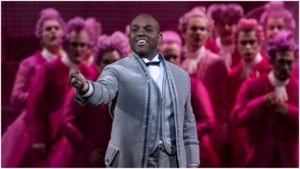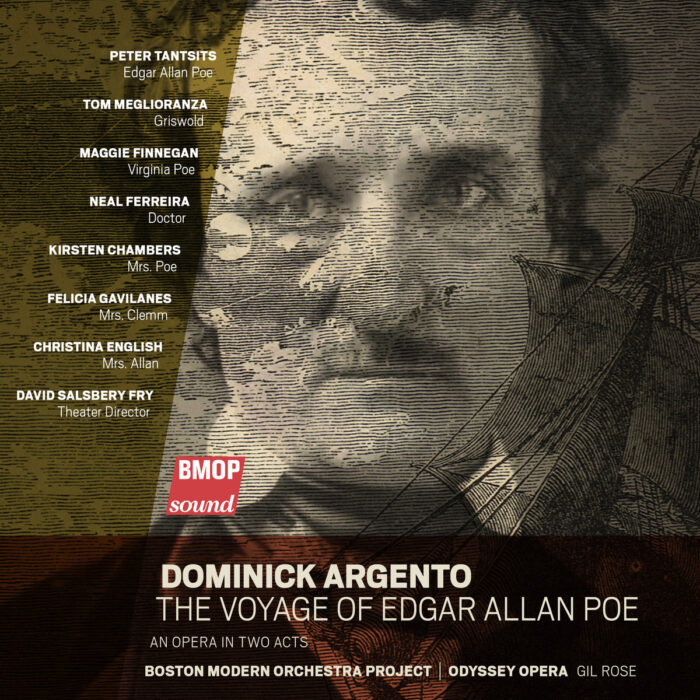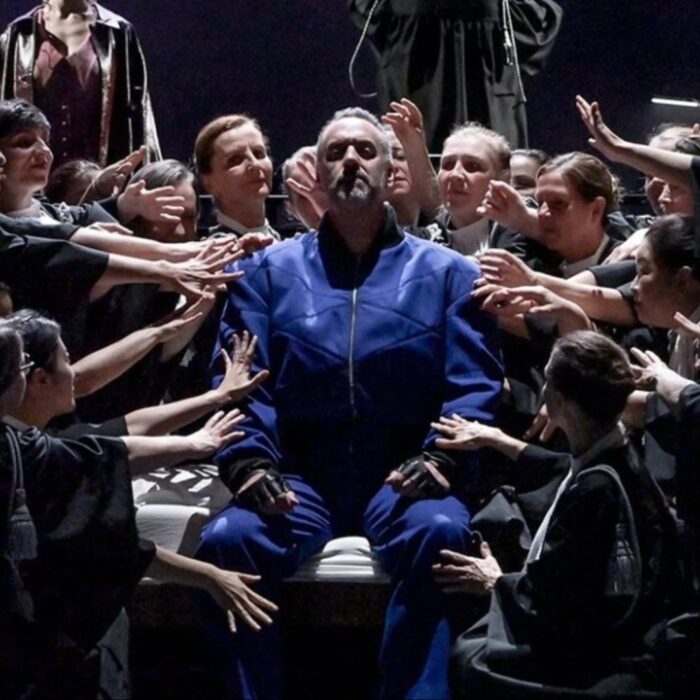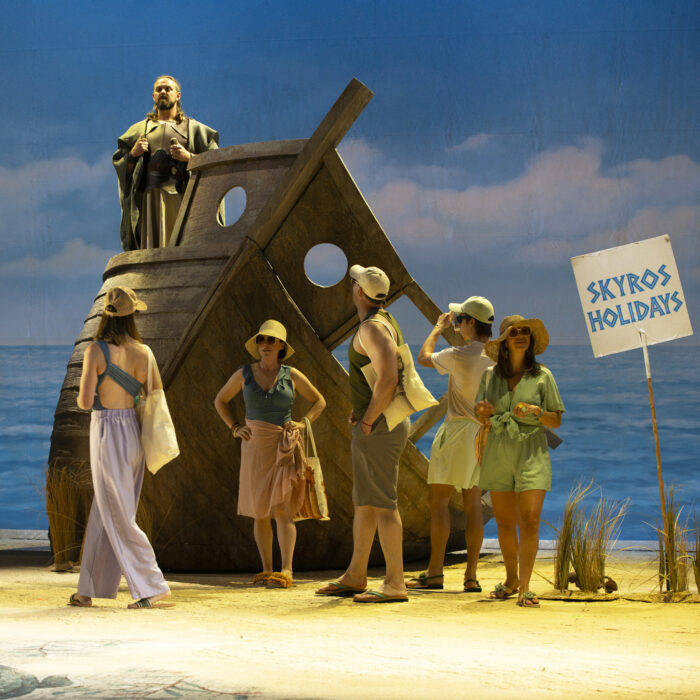
Palau de les Arts 2020-21 Review: La Cenerentola
Anna Goryachova & Lawrence Brownlee Shine in Laurent Pelly’s Exquisite Production
By Mauricio VillaThis review belongs to the opening night on the 10th December
“La Cenerentola” is one of Rossini’s most enduring works and has remained a fixture of the standard repertory since since its premiere in 1817. Based on the iconic Cinderella fairy tale, it has brought out the best in directors over the ages and singers who revel in Rossini’s joyous music.
That was undeniably the case in Valencia where director Laurent Pelly and a talented cast of singers elevated this work to unbelievable heights.
The production by Pelly is what you would expect of the French director: a great musical comedy. Everyone dances in this production: solo singers, the choir, and even the sets. The curtain rises up and we see a vast, empty space with Angelina in the middle dressed as an actual cleaning lady. But it is not long before platforms begin to move in and out which transforms the space into a house and a palace.
Pelly divides up the space using semi-transparent screens that lower down, move diagonally and cross the stage, dividing up space into two very different scenes. Color plays a very important part in the set design: the house of Don Magnifico is in grey, dark green, brown, while on the other side of the stage stands the palace where everything is bright pink. It is mesmerizing how Pelly connects the movements of the sets with the music, the performers, and the lighting.
It is amusing, irreproachable theatrical work, with meticulous stage directing of the singers. The result is funny without overacting while constant on-stage action makes the opera frenetic and hysterically funny.
Headliners
Mezzo-soprano Anna Goryachova played the title role. When she sang her first lines: “Una volta c’era un re” I thought I was listening to an Ammeris or Azucena. Her voice is big and dark, especially in the lower register. It was difficult to believe that such a heavy low voice was capable of singing all the scales, roulades, and cadenzas. But her performance was a showcase of perfect vocalita, clean coloratura, and unbelievably enormous high notes.
Rossini wrote the part quite well. The mezzo does not have a solo aria until the end of the opera, and the tessitura rises little by little, keeping the first vocal appearances mostly inside the stave, which is a comfortable zone for a mezzo. Her lines are extremely fluoride, however, and Goryachova traveled fast and clean through her lines, always with tendency to go low.
It was in her entrance at the palace, “Sprezzo quei don che versa,” when Rossini writes a scale from low B flat to high B flat, that we saw how Goryachova can expertly lighten her voice to do coloratura in the high register. The highlight of her performances was her final aria and rondo: “Nacqui all’affanno e al pianto” where Rossini stretches the tessitura and demands from the mezzo to sing between low G sharp and high B natural. She showed a display of vocal fireworks, breath control, and clean coloratura. Again, she lightened the voice for the several ascensions to B natural but emitted a strong B natural at the end of the rondo. Goryachova is a voice that is going places and one to pay attention to.
American tenor Lawrence Brownlee, considered one of the three best current Rossini performers, sang the part of the prince Don Ramiro. Considering the demanding and stratospheric operas that he usually sings, this particular work was a piece of cake for him. The audience had a sense of confidence and relaxation because all the notes and coloratura were easily dispatched.
Brownlee has a leggero voice, with a fair vibrato and decent volume. It is not a big voice but in this repertoire it carries easily over the orchestra. Despite of not having stratospheric notes the tessitura is truly high, keeping the voice of the tenor around high A natural all the time. His first appearance — the duet: “un suave non so che” — already demands a high A sharp and a B natural which Brownlee emitted effortlessly and always sul fiato of the coloratura line. His big moment came at the beginning of Act Two with his aria “Si ritrovarla io giuro” which, despite the coloratura not being as florid as other passages for the tenor, demands four high Cs. Brownlee not only kept the notes ringing and beautifully supported, but interpolated two more high Cs, holding the last one until the last bar of the orchestra. He made the aria sound easy and fun – something he did throughout the rest of the opera.
Comic Masters
Carlos Chausson sang Don Magnifico. He is a veteran and a specialist in Buffo characters, and he showed his mastery of the repertoire. He has a potent metallic voice, which enables him to really sing fast and parlato lines and he avoids giving in to the bad tendency to talk the parlato parts as often happens with some singers. On top of the amazing qualities of his voice, his acting is impeccable. The payoff for his performance was always funny because he always acted in a realistic way; it was his truth on stage that made the situations so comedic. It really was a pleasure to see him on stage.
Spanish baritone Carles Pachon portrayed Dandini. He has a beautiful timbre, modest volume and agilita. This role is written with extreme coloraturas too. His entrance aria. “come un’apene giorni d’aprile,” has fast roulades and scales in nearly every line. The tessitura is very high with several ascensions to high F. But the aria proved to be no problem to Pachon who went cleanly and effortlessly through every note. His interpretation of the “false” prince was funny and amusing.
Young Italian bass Ricardo Fassi played Alidoro. He has a nice velvet quality in his voice, his legato singing is stunning, and his acting abilities are pronounced. But he was the only member of the cast whose voice did not carry well over the orchestra. I wonder if he was not in top form, because low voices tend by nature to have more volume.
The interpretation of the two stepsisters by Larisa Stefan and Evgeniya Khomutova was splendid. They were hilarious, funny and their voices combined well together.
Carlo Rizzi’s reading of Rossini’s score was controlled, secure, and effective but it missed the brightness of Rossini. The famous “crescendo Rossiniano” lacked spark and life. Somehow it was too perfect, needing more spontaneity and dynamism to get closer to the Rossinian style. The choir did its utmost, adding to the opera’s charm.
Ultimately, this was a brilliant production with a splendid cast that made Rossini’s opera shine at Palau De Les Arts.


